This thread has lost a bit of momentum lately. Mainly because people don't seem to grasp the concept of Classic Monitor designs that win a cigar! And that you might be inspired to build with modern components. 
So I'll try and get it going again. I've already said a lot of nice things about Marco_Gea's PA/cone tweeter build.
Here's the KLH Model 6 with the simple filter in attachments:
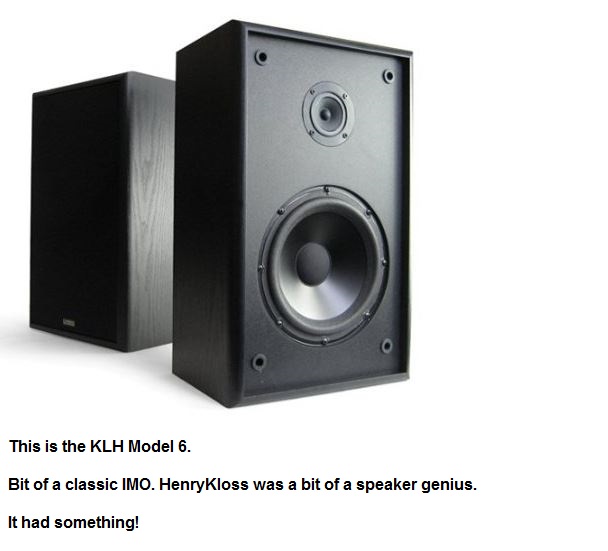
This model was introduced in 1958 and designed by Henry Kloss. The bass is a big and tidy 8-10" paper unit using Acoustic Suspension for the bass loading, which really means closed box, floppy surround and high mass cone.
There's still a big fanbase for KLH, Advent and Acoustic Research. The second really good speaker I ever heard was the 8" two way AR4, which could fill a big room with good and loud sound. In theory, acoustic suspension offers the lowest distortion, because the air spring is very linear.
A modern driver doing similar things might be this:
H1288-08 CA22RNX
Cone tweeters were very much the vogue then and ferrofluid unheard of. What's unusual about them is that you can use them with the 1.4kHz Fs resonance within the audible band, they have a natural rejection of bass frequencies, unlike most domes. So they often got a simple 3.3uF capacitor or such.
A modern equivalent:
HT-22/8
Here's my take on the concept. I've used a bass filter that really does very little beyond slightly damping the voicecoil in the mids, very little bafflestep so they place close to the wall. I used a second order tweeter because it models nicely. The FR of the Monacor will be slightly better than the TW70 I did the modelling with.
Interestingly, if I use a dome tweeter, I get driven to a steeper 2nd order bass and a third order tweeter like the old KEF designs. But I am very pleased with these. They really do sound VERY nice. They have solid bass and a very musical sound which just gets you into the music. In fact it is weird, but I'd swear the music plays slower through these.
I must also thank Marco_Gea for the ideas that led to these. Top man!
So I'll try and get it going again. I've already said a lot of nice things about Marco_Gea's PA/cone tweeter build.
Here's the KLH Model 6 with the simple filter in attachments:

This model was introduced in 1958 and designed by Henry Kloss. The bass is a big and tidy 8-10" paper unit using Acoustic Suspension for the bass loading, which really means closed box, floppy surround and high mass cone.
There's still a big fanbase for KLH, Advent and Acoustic Research. The second really good speaker I ever heard was the 8" two way AR4, which could fill a big room with good and loud sound. In theory, acoustic suspension offers the lowest distortion, because the air spring is very linear.
A modern driver doing similar things might be this:
H1288-08 CA22RNX
Cone tweeters were very much the vogue then and ferrofluid unheard of. What's unusual about them is that you can use them with the 1.4kHz Fs resonance within the audible band, they have a natural rejection of bass frequencies, unlike most domes. So they often got a simple 3.3uF capacitor or such.
A modern equivalent:
HT-22/8
Here's my take on the concept. I've used a bass filter that really does very little beyond slightly damping the voicecoil in the mids, very little bafflestep so they place close to the wall. I used a second order tweeter because it models nicely. The FR of the Monacor will be slightly better than the TW70 I did the modelling with.
Interestingly, if I use a dome tweeter, I get driven to a steeper 2nd order bass and a third order tweeter like the old KEF designs. But I am very pleased with these. They really do sound VERY nice. They have solid bass and a very musical sound which just gets you into the music. In fact it is weird, but I'd swear the music plays slower through these.
I must also thank Marco_Gea for the ideas that led to these. Top man!
Attachments
-
 KLH Model 6 Crossover.PNG36 KB · Views: 962
KLH Model 6 Crossover.PNG36 KB · Views: 962 -
 Monitor Audio 26-01-2016 Phase.PNG24.9 KB · Views: 203
Monitor Audio 26-01-2016 Phase.PNG24.9 KB · Views: 203 -
 Moitor Audio 26-01-2016 FR.PNG23.1 KB · Views: 715
Moitor Audio 26-01-2016 FR.PNG23.1 KB · Views: 715 -
 Monitor Audio 26-01-2016.PNG6.9 KB · Views: 1,404
Monitor Audio 26-01-2016.PNG6.9 KB · Views: 1,404 -
 Modified_MA-R300MD_HT22-8.jpg79 KB · Views: 961
Modified_MA-R300MD_HT22-8.jpg79 KB · Views: 961 -
 Monacor HT22-8 Cone tweeter FR.PNG30.4 KB · Views: 959
Monacor HT22-8 Cone tweeter FR.PNG30.4 KB · Views: 959
I don't know that there are many closed box (Qts=0.5) drivers around anymore really. All is reflex Qts=0.38 or less these days! Big magnets,in other words.
Let's start with a couple of classic designs in this 8" style. Mr. Joachim Gerhard's (and we love Joachim) Sonics Arkadia 2400 Euro speaker:
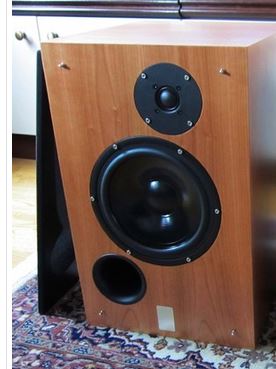
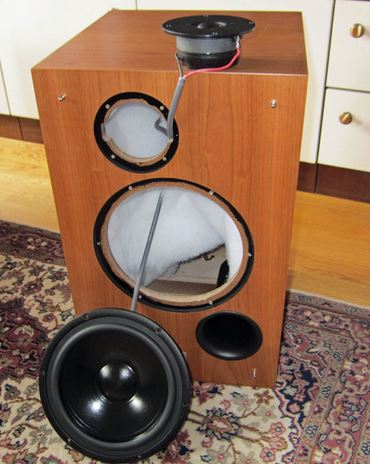
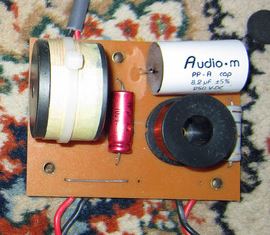
I would think these are the drivers;
H1288-08 CA22RNX
H1189-06 27TDFC
Joachim is using a simple and lowish second order 1.5-2 kHz crossover there IMO. That's OK with a really good tweeter. I didn't consider it an option with a cone tweeter, but I could be wrong.
There's another way to do this sort of thing as in the SEAS Njord design which is simpler and rougher. Below.
TBH, it's all a trade off. I use lots of woofers with the circuit below. The SEAS is 1mH Le and 6 R DC, so you'd get away with a smallish 3.3R in the bass shunt IMO. The Visaton W200S is a massive 2.2mH Le, comes with bafflestep built in. So needs 7.5R to avoid a peak at crossover.
The third order is definitely the least distorted and smoothest with less bass cone breakup around 5-7kHz. But I'm still enjoying Marco-Gea's shallower second order style. It's very dynamic.
Let's start with a couple of classic designs in this 8" style. Mr. Joachim Gerhard's (and we love Joachim) Sonics Arkadia 2400 Euro speaker:



I would think these are the drivers;
H1288-08 CA22RNX
H1189-06 27TDFC
Joachim is using a simple and lowish second order 1.5-2 kHz crossover there IMO. That's OK with a really good tweeter. I didn't consider it an option with a cone tweeter, but I could be wrong.
There's another way to do this sort of thing as in the SEAS Njord design which is simpler and rougher. Below.
TBH, it's all a trade off. I use lots of woofers with the circuit below. The SEAS is 1mH Le and 6 R DC, so you'd get away with a smallish 3.3R in the bass shunt IMO. The Visaton W200S is a massive 2.2mH Le, comes with bafflestep built in. So needs 7.5R to avoid a peak at crossover.
The third order is definitely the least distorted and smoothest with less bass cone breakup around 5-7kHz. But I'm still enjoying Marco-Gea's shallower second order style. It's very dynamic.
Attachments
Here's the KLH Model 6 with the simple filter in attachments:

I don't know what that thing in the picture is, but it's certainly not Henry Kloss' KLH6 from 1958.
Here's a real KLH6:
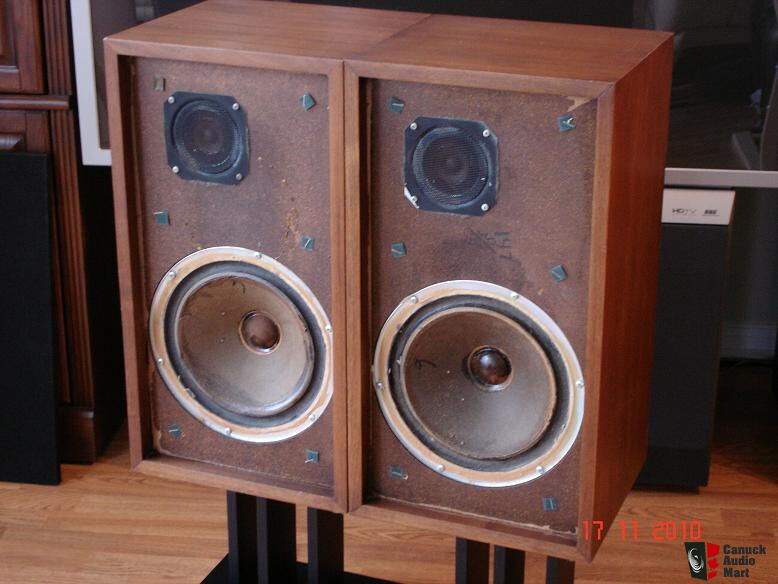
I don't know what that thing in the picture is, but it's certainly not Henry Kloss' KLH6 from 1958.
They are Cambridge Sound Works Model 6s from not that long ago.
Apparently somehow linked close enough to Henry Kloss to use his name.
They retailed for $149 when new.
...In theory, acoustic suspension offers the lowest distortion, because the air spring is very linear...
Hi,
Sorry to pick up on this, but it occurs to me that the air spring won't necessarily be very linear, as Boyle's Law states that Pressure is inversely proportional to Volume. (This is for an isothermal system, which is what a stuffed sealed box would approximate to.)
This means that, as you push the cone inwards, each increment in cone displacement will be accompanied by an increasing resistance. Conversely, as you pull the cone outwards, each increment in cone displacement will be accompanied by a decreasing resistance. Or, put another way, you need more force to push a cone inwards for a given displacement than you do to pull it out.
This effect will be worst for large cones, small boxes and large displacements. However, this will only really affect behaviour below and around system resonance, as the speaker cone is mass-controlled above resonance.
So, we'd expect to get even-order harmonic distortion at low frequencies. The most noticeable effect would be on speakers with an equalised bass response (like some subwoofer designs), because these have the most output below resonance. Could this be one reason why many listeners prefer these types of woofer/subwoofer design?
Interesting to note that, whilst there might be significant low-even-order HD, higher frequencies won't be much affected, since the cone's mass will dominate. So, the fact that the spring-rate is being modulated by the music's bass content won't materially affect the higher frequency content, and therefore IMD will be low.
I don't know that there are many closed box (Qts=0.5) drivers around anymore really. All is reflex Qts=0.38 or less these days! Big magnets,in other words.
Here is a nice modern 8in driver with Qts circa 0.5, great sensitivity and nice price. Dayton PA200-8.
Dayton Audio PA200-8 8" Pro Woofer Speaker
I have been considering using this in an upcoming build.
I've enjoyed this thread - some interesting contributions. Thanks for reviving it, Steve.
I recently unearthed a pair of Leak Sandwich 150s from the darker recesses of Ted's workshop. They fall into Steve's category of classic monitor - 5" sandwich cone bass, 2" cone tweeter - although they predate the classic BBC monitors. The Leaks have a chipboard cabinet damped with bitumen pads - perhaps that's where the Beeb got the idea as I believe a number were sold to broadcasting organisations.
The sandwich cone bass units (aluminium skin either side of a polystyrene core) are very stiff and light. Crossover is 1st order around 3.5kHz and given their age, the caps could doubtless do with an upgrade.
They sound surprisingly fine. The treble is a little rough but the bass is very nice.
I recently unearthed a pair of Leak Sandwich 150s from the darker recesses of Ted's workshop. They fall into Steve's category of classic monitor - 5" sandwich cone bass, 2" cone tweeter - although they predate the classic BBC monitors. The Leaks have a chipboard cabinet damped with bitumen pads - perhaps that's where the Beeb got the idea as I believe a number were sold to broadcasting organisations.
The sandwich cone bass units (aluminium skin either side of a polystyrene core) are very stiff and light. Crossover is 1st order around 3.5kHz and given their age, the caps could doubtless do with an upgrade.
They sound surprisingly fine. The treble is a little rough but the bass is very nice.
Last edited:
Hi,
Sorry to pick up on this, but it occurs to me that the air spring won't necessarily be very linear, as Boyle's Law states that Pressure is inversely proportional to Volume. (This is for an isothermal system, which is what a stuffed sealed box would approximate to.)
You can of course reduce distorting bass excursion by wall mounting or using a proper bass unit, reflex or closed box. It works well enough. I was listening to a Scanspeak 18W-8545-00 5.1 system last week. 5 wall mounted MTM speakers with 4X 15" subs built in too. RAAL ribbon tweeters, but I suppose you could use two small cone tweeters for cheapness.
Rather good, albeit LR4 dispersion 15 degrees above and below axis could have been be better and TBH, Joe D'Appolito designed for BW3 in his work which might be worth trying. You needed to sit in the sweet spot, especially in 2 channel stereo. Very tidy frequency response with the Scanspeak, rather like an 8" unit. The system was so well set up and balanced that you didn't hear bass as such, just the solid foundation and acoustic at the bottom end. No boom there.
I was interested that you couldn't hear combing as such, just a falloff at the top end. Also interesting was the use of a rockwool layer on the front baffle. Troels Gravesen does a design here with this unit: http://www.troelsgravesen.dk/CSM.htm
The Dayton Audio PA200-8 92dB Le=1mH woofer below right looks doable at 2.5kHz crossover, but you will have the PA compromise of lack of low bass.
Attachments
Last edited:
I've enjoyed this thread - some interesting contributions. Thanks for reviving it, Steve.
I recently unearthed a pair of Leak Sandwich 150s from the darker recesses of Ted's workshop. They fall into Steve's category of classic monitor - 5" sandwich cone bass, 2" cone tweeter - although they predate the classic BBC monitors. The Leaks have a chipboard cabinet damped with bitumen pads - perhaps that's where the Beeb got the idea as I believe a number were sold to broadcasting organisations.
The sandwich cone bass units (aluminium skin either side of a polystyrene core) are very stiff and light. Crossover is 1st order around 3.5kHz and given their age, the caps could doubtless do with an upgrade.
They sound surprisingly fine. The treble is a little rough but the bass is very nice.
Looks like the old Wharfedale plastic mid/tweeter.
I do find they (cone tweeters) sound better with a second order filter. Improves power handling for one thing. Even something as simple as this 3kHz crossover might be worth trying with a bit of attenuation, say 22R across the tweeter and a series resistor in front. Close to the wall.
HW 2/70 NG - 8 Ohm
How hard can it be?
Attachments
It is a strange thing that a thread about, say, resistor quality will run for 50 pages, but anything truly practical seems to die a death rapidly here. 
We have a bit of interest currently in the classic little 5" bass plus 1" tweeter arrangement, exemplified by the legendary BBC LS3/5A broadcast van monitor, here splendidly recreated by cwmartin, with scant regard for rebating the drivers. But, as they say, the perfect is often the enemy of the good...
http://www.diyaudio.com/forums/multi-way/262760-can-one-build-better-non-ls3-5a-speaker-based-t27s-b110s-43.html
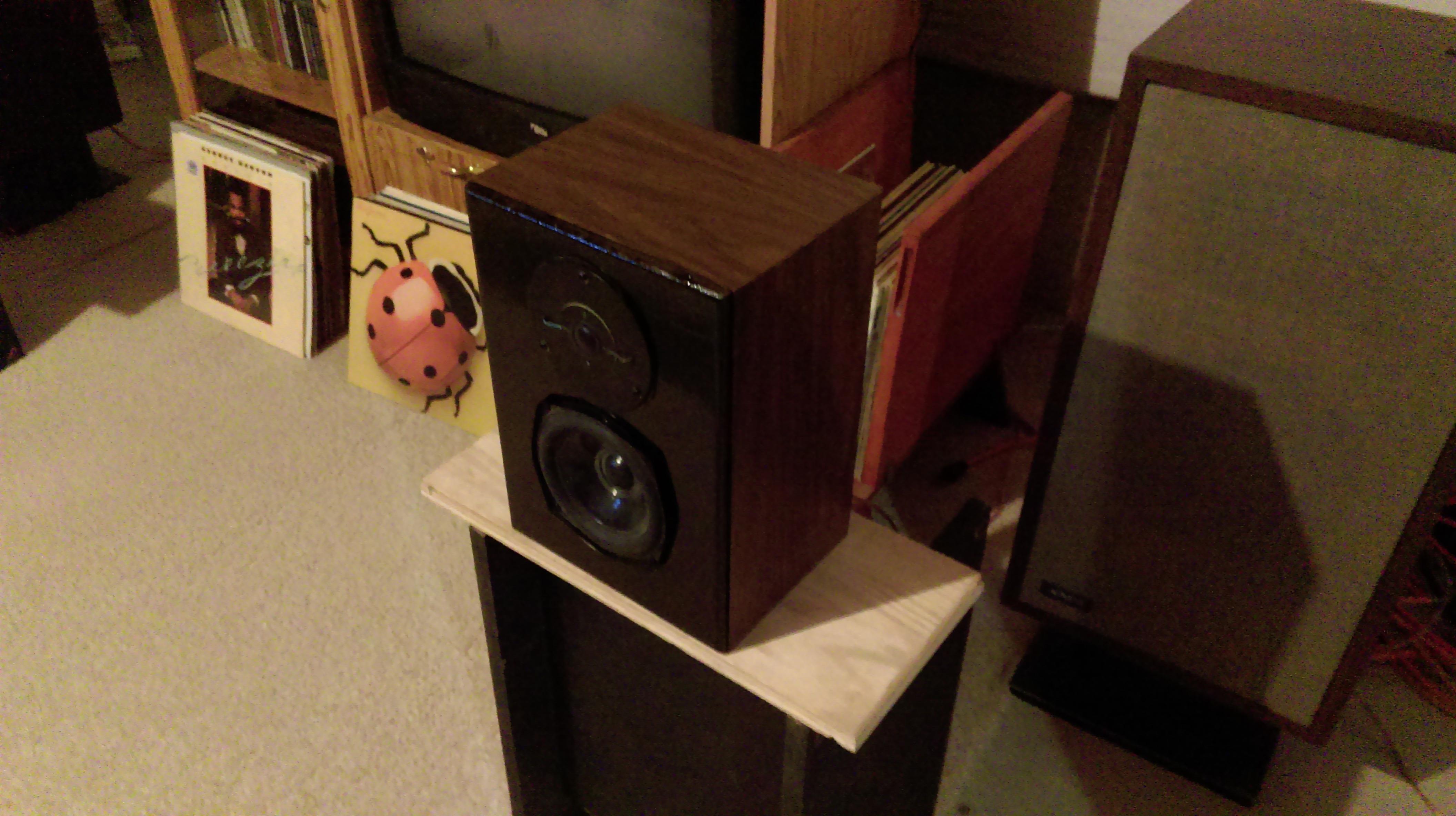
We know the physics of this sort of thing. No deep bass, no great loudness. But great midrange and voices. If you're not in a van, good in a bedroom.
So the question in the thread was whether you could improve it.
I think ShaneF did.
http://www.diyaudio.com/forums/multi-way/289344-seas-ca15rly-x2-cabinet-volume-suggestions-6.html
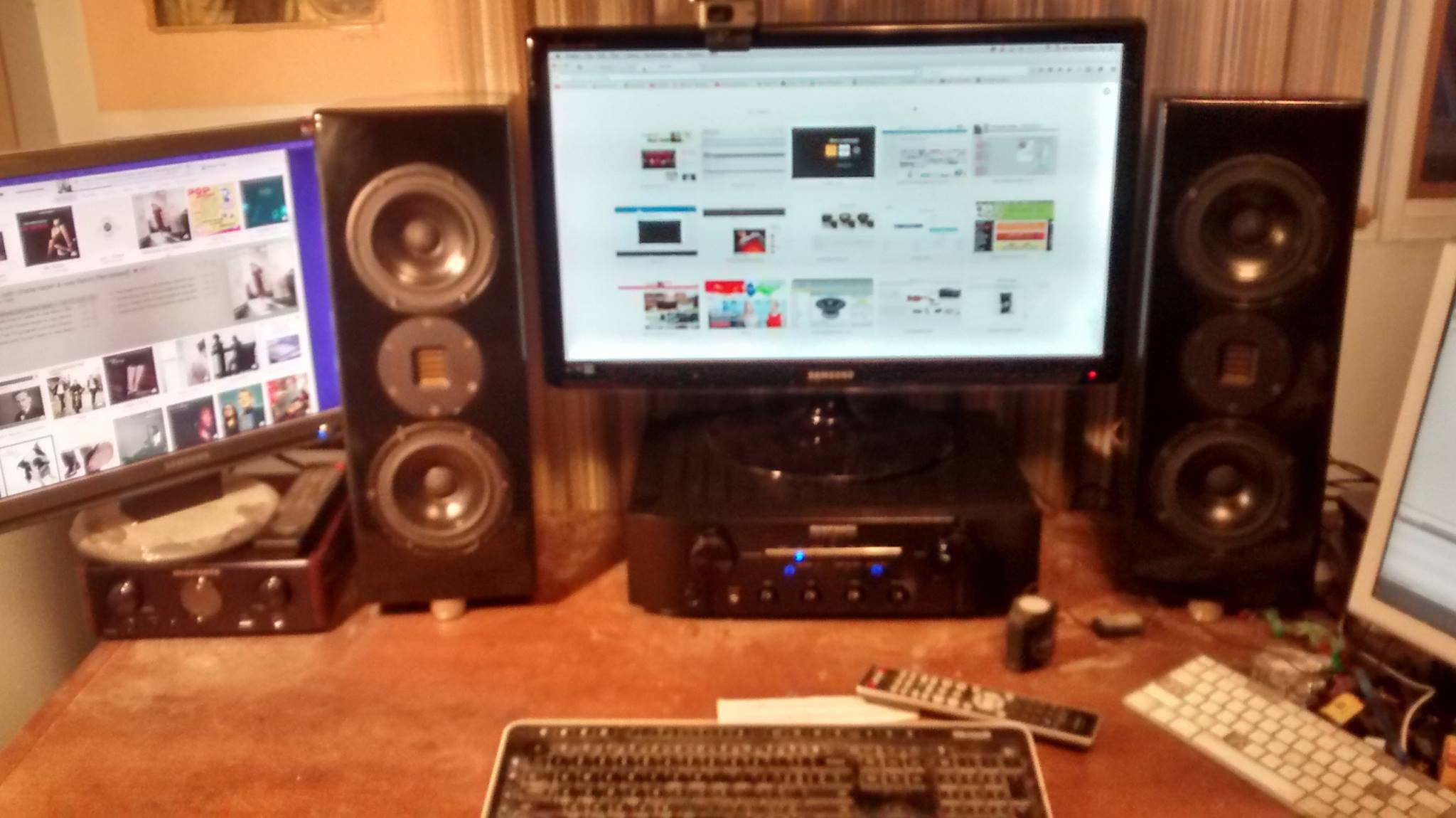
It's gotta go louder with less distortion. It's still not got big room bass, but ShaneF did a subwoofer. The Airborne ribbon RT-4001 tweeter has a more appropriate dispersion for an MTM design.
Troels Gravesen does both types of speaker here: Vifa PL14WJ-
Either way... a classic monitor, IMO. Nice work, guys. Have a gold star.
We have a bit of interest currently in the classic little 5" bass plus 1" tweeter arrangement, exemplified by the legendary BBC LS3/5A broadcast van monitor, here splendidly recreated by cwmartin, with scant regard for rebating the drivers. But, as they say, the perfect is often the enemy of the good...
http://www.diyaudio.com/forums/multi-way/262760-can-one-build-better-non-ls3-5a-speaker-based-t27s-b110s-43.html

We know the physics of this sort of thing. No deep bass, no great loudness. But great midrange and voices. If you're not in a van, good in a bedroom.
So the question in the thread was whether you could improve it.
I think ShaneF did.
http://www.diyaudio.com/forums/multi-way/289344-seas-ca15rly-x2-cabinet-volume-suggestions-6.html

It's gotta go louder with less distortion. It's still not got big room bass, but ShaneF did a subwoofer. The Airborne ribbon RT-4001 tweeter has a more appropriate dispersion for an MTM design.
Troels Gravesen does both types of speaker here: Vifa PL14WJ-
Either way... a classic monitor, IMO. Nice work, guys. Have a gold star.
In order to to revitalise this very interesting and useful thread, I would like to add another classic from the UK.
Overall, I am not completely sold on BBC monitor derivatives due to their limitations, but it is impossible to ignore their (often) outstanding capabilities in the midrange.
I have no experience with the original (and 'ultimate') Mission 770's, but I have owned and/or listened to many of their later models that share their 'intimate musicality'. People who don't require high listening levels for complex music could be perfectly happy with these.
I enclosed an article on Farad Azima, designer of the 770's and founder of Mission Electronics from hi-finews.
Nine iconic British hi-fi speakers from the 1970s and 1980s: Mission 770, Naim SBL, Mordaunt-Short Pageant II, KEF 104-2, Acoustic Energy AE1, Linn Isobarik, Celestion SL6, Gale GS401, Bowers & Wilkins DM110 (image from audio-icons):

An externally hosted image should be here but it was not working when we last tested it.
Overall, I am not completely sold on BBC monitor derivatives due to their limitations, but it is impossible to ignore their (often) outstanding capabilities in the midrange.
I have no experience with the original (and 'ultimate') Mission 770's, but I have owned and/or listened to many of their later models that share their 'intimate musicality'. People who don't require high listening levels for complex music could be perfectly happy with these.
I enclosed an article on Farad Azima, designer of the 770's and founder of Mission Electronics from hi-finews.
Nine iconic British hi-fi speakers from the 1970s and 1980s: Mission 770, Naim SBL, Mordaunt-Short Pageant II, KEF 104-2, Acoustic Energy AE1, Linn Isobarik, Celestion SL6, Gale GS401, Bowers & Wilkins DM110 (image from audio-icons):

Attachments
Last edited:
In 1976, or thereabouts, Hi-Fi for Pleasure ran a massive speaker test on a wide range of popular models. It was the first time a UK magazine had run a test like this, using an experienced listening panel and double blind throughout. The test was conducted by Martin Colloms.
The results were surprising with the Mordaunt Short Pageant coming out top, beating Spendors and the like. Runners up were something called a LS3/5a and a little monitor from B&W, the DM5. They admitted afterwards that the DM5 actually fell below the price range selected for the test.
and a little monitor from B&W, the DM5. They admitted afterwards that the DM5 actually fell below the price range selected for the test.

The results were surprising with the Mordaunt Short Pageant coming out top, beating Spendors and the like. Runners up were something called a LS3/5a

Godfather of the mini monitors?
The Goodmans Maximus from the mid 1960s. I have never heard these, but they are supposed to be excellent performers. Component wise they are truly high end compared to most loudspeakers available back in the day.
The Goodmans Maximus from the mid 1960s. I have never heard these, but they are supposed to be excellent performers. Component wise they are truly high end compared to most loudspeakers available back in the day.
Attachments
Last edited:
And a few more pictures:
Noticable are the steel baffle and that huge Alnico magnet.
Goodmans certainly knew how to make proper woofers and many have become classics and sought after.
An externally hosted image should be here but it was not working when we last tested it.
An externally hosted image should be here but it was not working when we last tested it.
An externally hosted image should be here but it was not working when we last tested it.
An externally hosted image should be here but it was not working when we last tested it.
An externally hosted image should be here but it was not working when we last tested it.
An externally hosted image should be here but it was not working when we last tested it.
An externally hosted image should be here but it was not working when we last tested it.
Noticable are the steel baffle and that huge Alnico magnet.
Goodmans certainly knew how to make proper woofers and many have become classics and sought after.
Last edited:
For anyone interested, here's a scan of the extensive loudspeaker test from HiFi for Pleasure Magazine of September 1976 that Colin referred to:
http://gotnorice.com/Speaker_test-Popular_Hi-Fi_1976.PDF
http://gotnorice.com/Speaker_test-Popular_Hi-Fi_1976.PDF
The gratuitous blonde draped over a speaker (it's a wig, of course...) is considered a bit suspect these days... 
I look for a flat impedance these days. We found one in the classic two way BBC monitor the Rogers LS5/9.
It looks a bit like this:
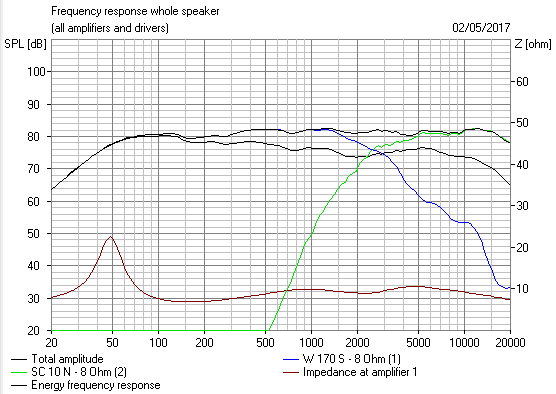
Not bad, eh. One of the secrets, I suspect. You can calculate these things here:
mh-audio.nl - Home
3-4dB of passive bafflestep and impedance correction of the bass Le inductance. Sounds good by all accounts.
An externally hosted image should be here but it was not working when we last tested it.
I look for a flat impedance these days. We found one in the classic two way BBC monitor the Rogers LS5/9.
It looks a bit like this:

Not bad, eh. One of the secrets, I suspect. You can calculate these things here:
mh-audio.nl - Home
3-4dB of passive bafflestep and impedance correction of the bass Le inductance. Sounds good by all accounts.
I love these trips down memory lane. The Mission 770 speaker driverwise is almost a Rogers LS5/9:

And the tiny Goodmans Maxim uses those old cone tweeters I so enjoy. Best with a third or 4th order filter around 3kHz, IMO, because they do fight you a bit, but you can do a lower second order too if you can tolerate a bit of distortion in favour of musicality.
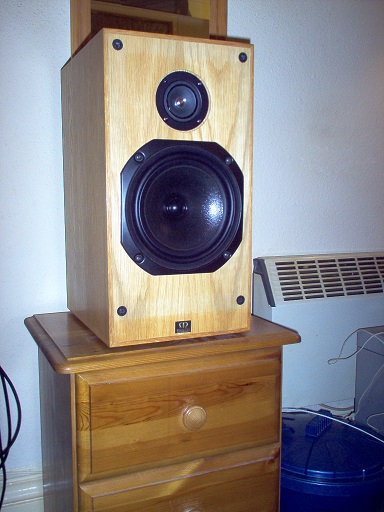
This is a monacor HT22/8. Very musical, if limited on dispersion at the 10kHz end, which might be curable with a supertweeter. I'm on it!

And the tiny Goodmans Maxim uses those old cone tweeters I so enjoy. Best with a third or 4th order filter around 3kHz, IMO, because they do fight you a bit, but you can do a lower second order too if you can tolerate a bit of distortion in favour of musicality.

This is a monacor HT22/8. Very musical, if limited on dispersion at the 10kHz end, which might be curable with a supertweeter. I'm on it!
I tend to agree Steve, flat impedance and reduction of phase (time alignment) anomalies seem important ingredients to achieve 'musicality'. At least from my experience, these may in the end turn out to be of greater importance than striving for a flat frequency response (which could suck life out of drivers).
- Home
- Loudspeakers
- Multi-Way
- Classic monitor designs?













